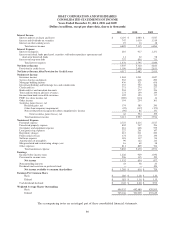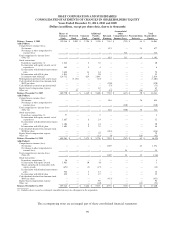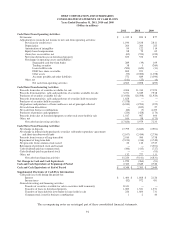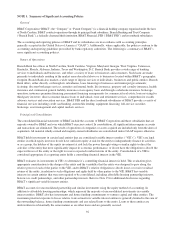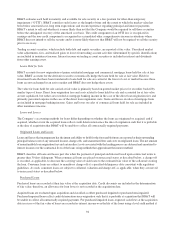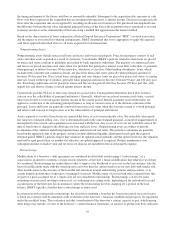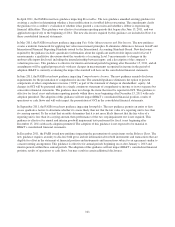BB&T 2011 Annual Report Download - page 97
Download and view the complete annual report
Please find page 97 of the 2011 BB&T annual report below. You can navigate through the pages in the report by either clicking on the pages listed below, or by using the keyword search tool below to find specific information within the annual report.
The entire amount of the allowance for credit losses is available to absorb losses on any loan category or lending-related
commitment.
The following provides a description of BB&T’s accounting policies and methodologies related to each of its portfolio
segments:
Commercial
The vast majority of loans in the commercial lending portfolio are assigned risk grades based on an assessment of
conditions that affect the borrower’s ability to meet contractual obligations under the loan agreement. This process
includes reviewing borrowers’ financial information, historical payment experience, credit documentation, public
information, and other information specific to each borrower. Risk grades are reviewed on an annual basis for all credit
relationships with total credit exposure of $1 million or more, or at any point management becomes aware of information
affecting the borrower’s ability to fulfill their obligations. For commercial clients where total credit exposure is less than
$1 million, BB&T has developed an automated loan review system to identify and proactively manage accounts with a
higher risk of loss. The “score” produced by this automated system is updated monthly.
On a quarterly basis, BB&T reviews all commercial lending relationships with outstanding debt of $5 million or more that
have been classified as substandard or doubtful. While this review is largely focused on the borrower’s ability to repay the
loan, BB&T also considers the capacity and willingness of a loan’s guarantors to support the debt service on the loan as a
secondary source of repayment. When a guarantor exhibits the documented capacity and willingness to support the loan,
BB&T may consider extending the loan maturity and/or temporarily deferring principal payments if the ultimate
collection of both principal and interest is not in question. In these cases, BB&T may not deem the loan to be impaired
due to the documented capacity and willingness of the guarantor to repay the loan. Loans are considered impaired when
the borrower (or guarantor in certain circumstances) does not have the cash flow capacity or willingness to service the
debt according to contractual terms, or it does not appear reasonable to assume that the borrower will continue to pay
according to the contractual agreement. BB&T establishes a specific reserve for each loan that has been deemed impaired
based on the criteria outlined above. The amount of the reserve is based on the present value of expected cash flows
discounted at the loan’s effective interest rate, and/or the value of collateral. BB&T has also established a review process
related to restructurings and other impaired loans that are in commercial lending relationships with outstanding debt of
less than $5 million at the balance sheet date. In connection with this process, BB&T establishes reserves related to these
loans that are calculated using an expected cash flow approach. These discounted cash flow analyses incorporate
adjustments to future cash flows that reflect management’s best estimate of the default risk related to restructurings based
on a combination of historical experience and management judgment.
BB&T also maintains reserves for collective impairment that reflect an estimate of losses related to non-impaired commercial
loans as of the balance sheet date. Embedded loss estimates for BB&T’s commercial loan portfolio are based on estimated
migration rates, which are estimated based on historical experience, and current risk mix as indicated by the risk grading process
described above. Embedded loss estimates may be adjusted to reflect current economic conditions and current portfolio trends
including credit quality, concentrations, aging of the portfolio, and significant policy and underwriting changes.
Retail
The majority of the allowance for loan and lease losses related to the retail lending portfolio is calculated on a collective basis
using a delinquency-based approach. Embedded loss estimates for BB&T’s retail lending portfolio are based on estimated
migration rates that are developed based on historical experience, and current risk mix as indicated by prevailing delinquency
rates. These estimates may be adjusted to reflect current economic conditions and current portfolio trends. The remaining
portion of the allowance related to the retail lending portfolio relates to loans that have been deemed impaired based on their
classification as a restructuring at the balance sheet date. BB&T establishes specific reserves related to these restructured
loans using an expected cash flow approach. The allowance for retail restructurings is based on discounted cash flow
analyses that incorporate adjustments to future cash flows that reflect management’s best estimate of the default risk related
to restructurings based on a combination of historical experience and management judgment.
Acquired Loans
The allowance for loan and lease losses related to (1) purchased impaired loans and (2) all loans acquired in an FDIC-
assisted transaction, is based on an analysis that is performed each period to estimate the expected cash flows for each of
97




